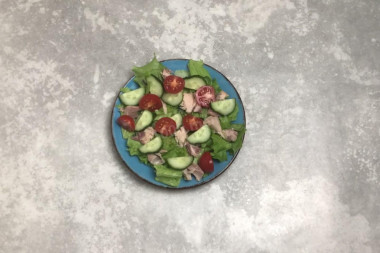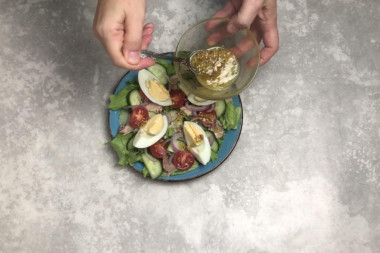Composition / ingredients
Step-by-step cooking
Step 1:

How to make PP tuna salad? Prepare the products. Take tuna in its own juice, not in oil. This will reduce the caloric content of the salad. Pre-boil the eggs and cool them. Instead of cherry, you can take large tomatoes, then you will need 2 pieces. Pre-wash the vegetables. Take mustard not spicy, but one that is delicious to eat. I took it with seeds.
Step 2:

Flip the tuna onto a sieve to drain the liquid.
Step 3:

Rinse the lettuce leaves well under running water, and then put them on a paper towel. Blot the leaves from all sides - excess moisture will quickly make them sluggish and withered.
Step 4:

If you have large tomatoes, then cut them into slices, cherry is enough to cut into halves.
Step 5:

Cut off the tips of the cucumber and cut it into slices.
Step 6:

Peel the onion and cut it into thin half rings.
Step 7:

Cut the eggs into quarters.
Step 8:

Take a plate. Tear the salad leaves on it. It is important to do this with your hands, and not cut with a knife, because from contact with metal, lettuce will oxidize and wither faster. Put the tuna on the salad leaves, breaking it into small pieces with your hands.
Step 9:

Add tomatoes, cucumber and onion half rings on top, after disassembling them into smaller pieces.
Step 10:

Put the egg quarters on top.
Step 11:

Prepare the dressing. Pour olive oil into a small cup, pour lemon juice into it, put a spoonful of mustard. Mix all the ingredients well with a spoon.
Step 12:

Lightly salt the salad. Note that tuna is quite salty. Pour the dressing over the salad and serve immediately. Salads with greens should not be kept seasoned for a long time - vegetables give juice, the greens get wet and become unappetizing. If you plan to prepare a salad in advance, then season and salt it immediately before serving.
I believe that this salad can be considered a recipe for proper nutrition, because it balances the main sources of nutrients - proteins, for which tuna and eggs are responsible, and fiber, for which fresh vegetables are responsible. Olive oil is responsible for fats, which are also needed by a person who monitors his diet. Take it of the highest quality, first pressed.
It is important to realize that there are no recipes or products in nature that are certainly useful to all people or unconditionally harmful to everyone. As with medicines, and in nutrition, there are indications and contraindications, daily individual consumption rates, and for most people all this is very personalized. At the same time, there are a lot of myths “about proper nutrition” (for example: fat is bad), which distort the very essence of this concept and in such a distorted form are distributed on the Internet and the media. Therefore, remember that any “PP recipe” will be related to proper nutrition only conditionally, do not take it as a dogma. And even if the author of the recipe, a “healthy nutrition specialist” or a nutritionist and fitness trainer calls something useful (PP) or harmful, it may not be so for you personally.
The opinion of the site administration about proper nutrition may not coincide with the opinion of the author of the PP recipe!
The calorie content of the products possible in the dish
- Onion - 41 kcal/100g
- Fresh cucumbers - 15 kcal/100g
- Chicken egg - 157 kcal/100g
- Egg white - 45 kcal/100g
- Egg powder - 542 kcal/100g
- Egg yolk - 352 kcal/100g
- Ostrich egg - 118 kcal/100g
- Mustard canteen - 417 kcal/100g
- Mustard - 417 kcal/100g
- Salt - 0 kcal/100g
- Lemon juice - 16 kcal/100g
- Olive oil - 913 kcal/100g
- Cherry tomatoes - 15 kcal/100g
- Canned tuna in its own juice - 96 kcal/100g
- Lettuce leaves - 12 kcal/100g








